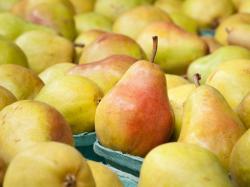'America's First Pear' To Begin Harvest July 7th
June 26, 2014 | 3 min to read

Sacramento, CA – The first Bartlett pears of the season are set to harvest in California’s Sacramento River growing region July 7. According to the official crop estimate set by the California Pear Advisory Board at its June 12th meeting, the state’s total crop of Bartlett pears is expected to be just over 2.6 million 36-pound packages, slightly down from the four-year average crop size of 2.9 million packages.
The majority of the state’s Bartletts, 1.5 million packages, will come from the early harvesting Delta River growing district, with harvest in Mendocino County expected on August 4 and on August 11 in Lake County.
California pear farmers are expecting an additional 550,000 packages of other pear varieties this season including 220,000 Golden Russet Bosc and 80,000 Starkcrimson along with smaller quantities of Bosc, Sunsprites, Comice, Forrelle, Seckel, French Butter and other red varieties.
In addition to setting its official crop estimate and harvest dates during its most recent Board meeting, the California Pear Advisory Board (CPAB) adopted a new brand positioning for Bartlett pears from California calling them “America’s First Pear.”
“We realized that Bartlett pears from California are unique because they have been produced in California since the very beginnings of the state’s commercial fruit industry dating all the way back to the California Gold Rush in the 1850s,” said Chris Zanobini, Executive Director of the CPAB. “California Bartletts are also the very first pear of the season to be harvested in the U.S. each year and consumer research shows Bartlett pears are the first choice of consumers when it comes to selecting a flavorful pear variety. The title of ‘America’s First Pear’ just seemed to be a good fit.”
Zanobini noted that CPAB has been working closely in its hometown of Sacramento, California to promote a locally-grown image and they have become a regular sponsor of the “America’s Farm to Fork Capital” program launched in 2013. The program promotes locally-grown agricultural products to Sacramento area consumers, retailers and restaurants. The concept of giving consumers locally-grown, sustainably-produced food is rapidly gaining in popularity throughout the country.
“California Bartlett pears fit a highly desirable image because they are produced by the kind of artisan farmers that today’s consumers want growing their food,” said Zanobini. “California Bartletts are grown by about 60 pear farming families, most of whom have been growing pears on the same land for generations. The average size of California pear farm is 130 acres and the average age of the orchards are between 30 and 100 years.
“California Bartletts provide consumers with an heirloom experience because this is the same product people can find in their local farmers market. They have been sustainably-grown for over 100 years by smaller, family farmers who are trusted and safe,” said Zanobini.
The California pear industry’s claims about sustainability are not just marketing hype, but are backed by research. During the past three years, the CPAB has participated in a program with the independent sustainability program design firm, SureHarvest, to assess the level of sustainable farming practices utilized by farmers. SureHarvest has found an exceptionally high level of adoption amongst California pear farmers of sustainable practices like non-chemical treatments for pests. According to the SureHarvest assessment, well over 90 percent of California pear farmers utilize practices like pheromone-mating disruption, scouting for pests and other Integrated Pest Management practices.
CPAB plans to launch an initial trade education effort this summer to communicate with grocery stores the benefits of selecting and staying with California Bartlett pears for the duration of the California pear season.
“This strategy allows retailers to maximize the pear category and to give consumers their favorite pear for longer,” explained Zanobini. “California pear farmers are confident we can work together with buyers to optimize their pear category profits.”
Zanobini noted the trade should look for new educational materials from CPAB along with some locally-based, innovative on-line consumer promotions beginning this season. For more information, please visit www.calpear.com.
Source: California Pear Advisory Board
